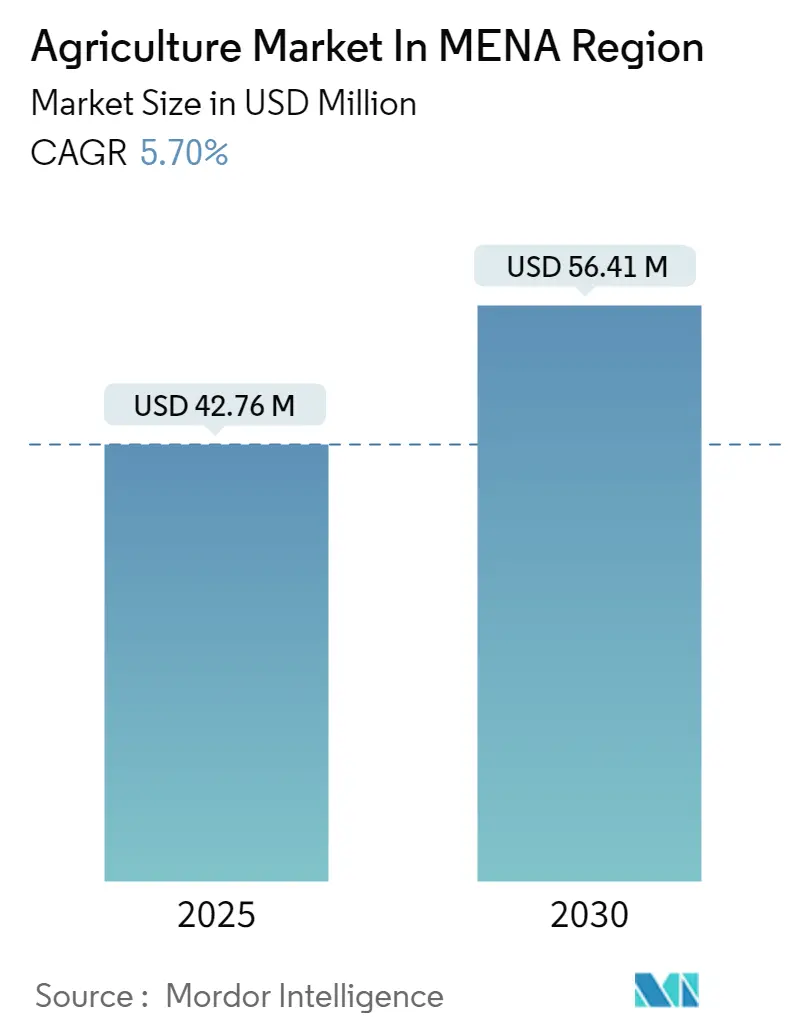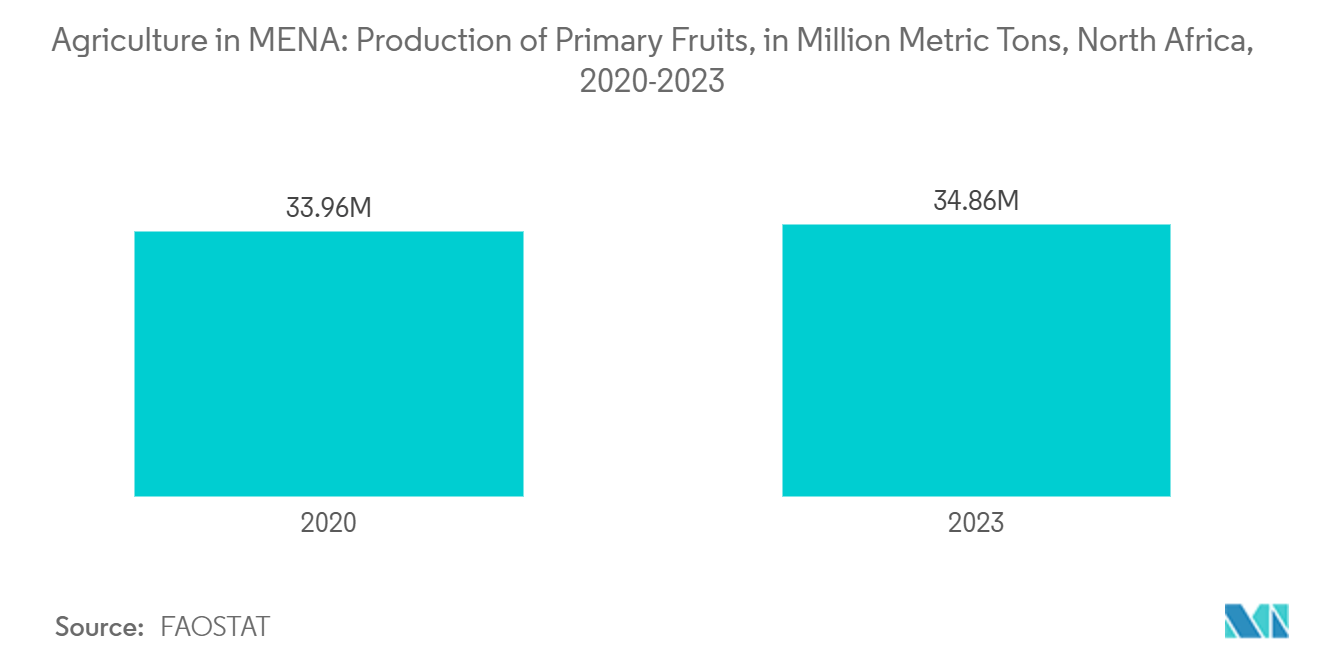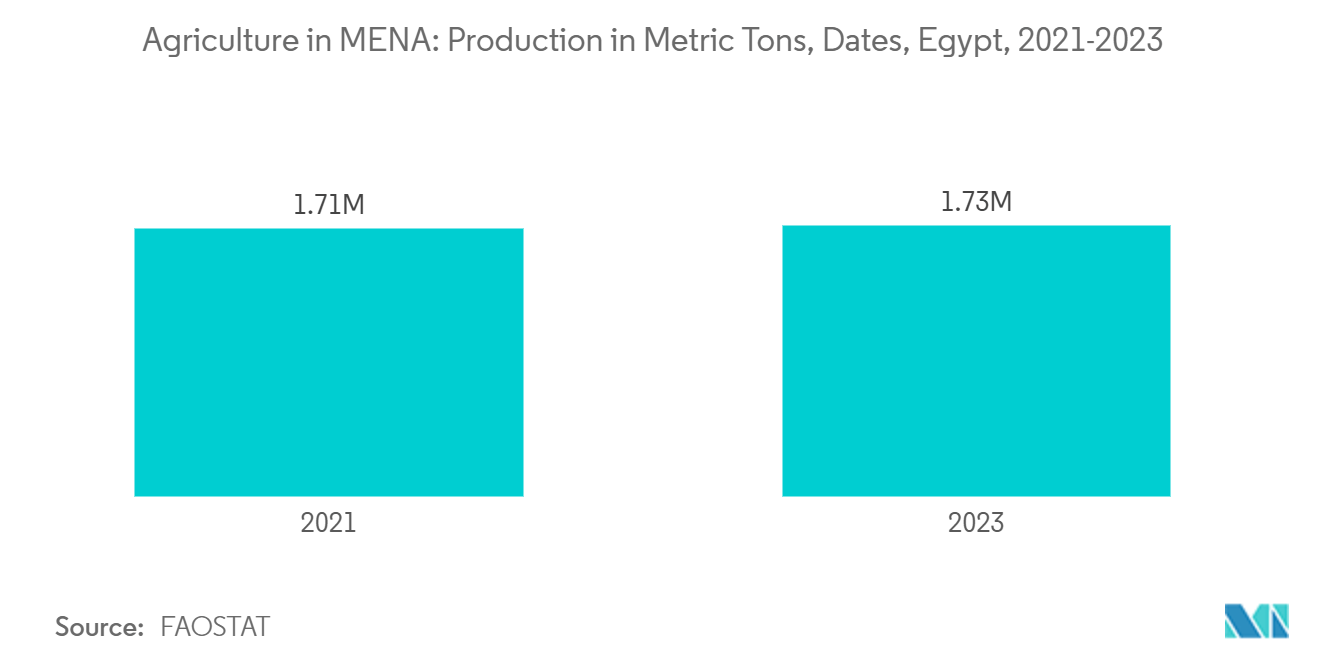Middle East and North Africa Agriculture Market Analysis
The Agriculture Market In MENA Region Industry is expected to grow from USD 42.76 million in 2025 to USD 56.41 million by 2030, at a CAGR of 5.7% during the forecast period (2025-2030).
- The Middle East and North Africa (MENA) region encompasses 14 low and middle-income countries or territories from Iran to Morocco. In 2023, the region's population reached 500.7 million, with 165.3 million residing in rural areas. Approximately 89 million people depend on agriculture, including fishing and livestock. The region spans 1,200 million hectares and features diverse environments.
- Agricultural practices in the region are diverse. Rainfed crops, including wheat, barley, legumes, olives, grapes, fruits, and vegetables, are cultivated during the wetter winter period. Irrigated areas support year-round cultivation, particularly of subtropical crops such as fruits and vegetables. Livestock, predominantly sheep and goats, play a significant role in many farming systems, creating important linkages between different agricultural systems.
- The MENA region faces a growing dependence on international markets for staple food products due to the increasing scarcity of arable land and water resources. In response, some governments have implemented water conservation measures, such as prohibiting the cultivation of water-intensive crops like wheat and green fodder. Food demand in the region is rising, primarily driven by population growth and increasing incomes.
- According to the Food and Agriculture Organization (FAO), land reform remains a significant challenge in the region. Many farmers maintain fragmented holdings without rationalization or consolidation processes, even in countries officially undertaking land reforms. Substantial changes have occurred mainly where larger operators can acquire land from smaller farmers. The reorganization of land holdings is widely recognized as essential for implementing technologies to conserve soil and water resources in the long term.
- The agriculture sector's growth in the region is projected to be driven by the effective use of agricultural resources, adoption of new technologies, and favorable policies. However, the sector faces constraints, including lower GDP in African countries and farm labor shortages, particularly for high-value crops. Despite these challenges, there has been an increased consumption of cereals and fruits in the region, reflecting a growing preference for healthy and nutritional diets.
Middle East and North Africa Agriculture Market Trends
Quest for Food Self-sufficiency is Driving Production
- Among the food security challenges in the region, undernourishment, poverty, low agricultural productivity under scarce natural resources, and food import dependency pose the main problems. To tackle the increasing dependency on imports, countries in the region are taking several measures to ramp up production, as there are opportunities to partially address food insecurity by increasing production.
- For instance, in 2022, a political blockade in Qatar turned into a boon for its food security as the Ministry of Economy and Commerce (MEC), in cooperation with shopping malls and large retail outlets, unveiled the "National Product" of the "Made in Qatar" initiative. Under this initiative, farmers are growing fruits and vegetables in greenhouses, which are being sold as goods bearing the slogan "National Product" prominently to facilitate consumers' access to these products.
- According to a Food and Agriculture Organization (FAO) report titled "The State of Food Insecurity in the World," Morocco has significantly reduced hunger by maximizing production from large-scale farms and supporting small-scale farms in reducing poverty and hunger through venture capitalism. According to Food and Agriculture Organization Corporate Statistical Database (FAOSTAT), the production of cereals in Morroco grew from 3.3 million metric tons in 2020 to more than 3.5 million tons in 2023. Similarly, in North Africa, the production of fruits and vegetables showed a significant rise in 2023 compared to 2020, with a production of more than 34.9 million metric tons of vegetables and 34.9 million metric tons of fruits in 2023. Thus, the quest for achieving food self-sufficiency is majorly driving agricultural production in the MENA region.
Egypt Dominates the Region
- Egypt is the region's highest producer of fruits and vegetables, closely followed by Iran. Fruits and vegetables are the most suitable crops for the climatic conditions of countries in the MENA region. The countries in the region direct their scarce water resources to more value-added crops, such as fruit and vegetables grown in greenhouses, as opposed to growing water-intensive cereal crops.
- According to the Food and Agriculture Organization (FAO), Egypt produced more than 14.3 million metric tons of primary fruits and 15.9 million metric tons of primary vegetables in 2023. Egypt is also a significant exporter of fruit and vegetables to the European Union. Major fruits and vegetables produced in the region are grapes, dates, watermelon, bananas, oranges, sugarcane, eggplants, and potatoes.
- In 2023, the production of dates increased by 1.5% compared to 2021 to reach a volume of more than 1.7 million metric tons, The Egyptian government has launched a food and agriculture project worth USD 3.3 billion in 2022 to increase the production output and has initiatives for integrated agriculture development programs such as the South Valley Development Project (Toshka), the Egyptian Rural Development Project, and the North and Central Sinai Development Project. Hence, the production of fruits and vegetables is likely to increase, which is projected to drive the whole agricultural sector in the country during the forecast period.
Middle East and North Africa Agriculture Market News
- July 2023: E20 Investment, a UAE-based agribusiness investment firm, manages over 4,000 hectares of farmland in Angola, France, and Uzbekistan, partnered with Israel's Netafim to launch large-scale farming projects in the Middle East and North Africa.
- September 2022: A new vertical farming facility was opened in Dubai, UAE, developed by a joint venture between Emirates Flight Catering and Crop one with an investment of USD 40 million for the facility.
- July 2022: Egypt government launched food and agriculture project worth USD 3.3 billion in 2022-2023 to expand production in the agriculture sector, adopt new technologies such as vertical farming, and focus on drafting new policies.
- July 2022: IHC and the DAL group signed a deal to develop an additional 162,000 ha of farmland in northern Abu Hamad. This extensive farming project, supported by the UAE government, will connect to a new port on Sudan's coast, which will be built and operated by the Abu Dhabi Ports Group. This initiative aims to enhance both nations' food security and trade systems.
Middle East and North Africa Agriculture Industry Segmentation
Agriculture is the science or practice of farming, including the cultivation of the soil to grow crops and the rearing of animals to provide food, wool, and other products. The Middle East and North Africa Agriculture Market is Segmented by Crop Type (Food Crops/Cereals, Fruits, Vegetables, and Oilseeds/Non-food Crops). The Report includes Production Analysis (Volume), Consumption Analysis (Value and Volume), Export Analysis (Value and Volume), Import Analysis (Value and Volume), and Price Trend Analysis for each of the abovementioned segments. The market estimation and forecasts are provided in value (USD) and volume (Metric Tons) for the above-mentioned segments.
| Food Crops/Cereals | Production Analysis |
| Consumption Analysis (Value & Volume) | |
| Import Analysis (Value & Volume) | |
| Export Analysis (Value & Volume) | |
| Price Trend Analysis | |
| Fruits | Production Analysis |
| Consumption Analysis (Value & Volume) | |
| Import Analysis (Value & Volume) | |
| Export Analysis (Value & Volume) | |
| Price Trend Analysis | |
| Vegetables | Production Analysis |
| Consumption Analysis (Value & Volume) | |
| Import Analysis (Value & Volume) | |
| Export Analysis (Value & Volume) | |
| Price Trend Analysis | |
| Oilseeds/Non-food Crops | Production Analysis |
| Consumption Analysis (Value & Volume) | |
| Import Analysis (Value & Volume) | |
| Export Analysis (Value & Volume) | |
| Price Trend Analysis |
| Production Analysis |
| Consumption Analysis (Value & Volume) |
| Import Analysis (Value & Volume) |
| Export Analysis (Value & Volume) |
| Price Trend Analysis |
| Production Analysis |
| Consumption Analysis (Value & Volume) |
| Import Analysis (Value & Volume) |
| Export Analysis (Value & Volume) |
| Price Trend Analysis |
| Production Analysis |
| Consumption Analysis (Value & Volume) |
| Import Analysis (Value & Volume) |
| Export Analysis (Value & Volume) |
| Price Trend Analysis |
| Production Analysis |
| Consumption Analysis (Value & Volume) |
| Import Analysis (Value & Volume) |
| Export Analysis (Value & Volume) |
| Price Trend Analysis |
MENA Agriculture Market Research FAQs
How big is the Agriculture Market In MENA Region Industry?
The Agriculture Market In MENA Region Industry size is expected to reach USD 42.76 million in 2025 and grow at a CAGR of 5.70% to reach USD 56.41 million by 2030.
What is the current Agriculture Market In MENA Region Industry size?
In 2025, the Agriculture Market In MENA Region Industry size is expected to reach USD 42.76 million.
What years does this Agriculture Market In MENA Region Industry cover, and what was the market size in 2024?
In 2024, the Agriculture Market In MENA Region Industry size was estimated at USD 40.32 million. The report covers the Agriculture Market In MENA Region Industry historical market size for years: 2019, 2020, 2021, 2022, 2023 and 2024. The report also forecasts the Agriculture Market In MENA Region Industry size for years: 2025, 2026, 2027, 2028, 2029 and 2030.
Our Best Selling Reports
MENA Agriculture Industry Report
Statistics for the 2025 Agriculture In MENA Region market share, size and revenue growth rate, created by Mordor Intelligence™ Industry Reports. Agriculture In MENA Region analysis includes a market forecast outlook for 2025 to 2030 and historical overview. Get a sample of this industry analysis as a free report PDF download.





